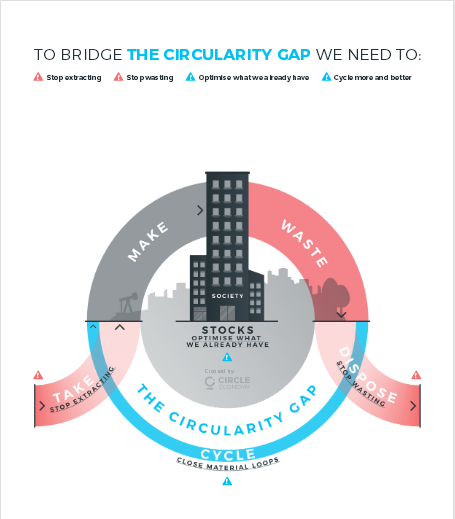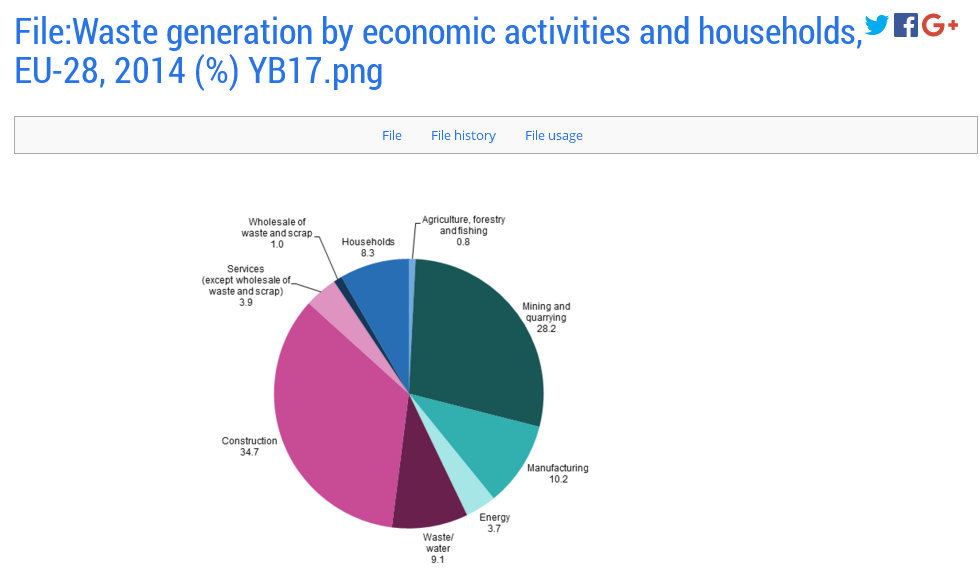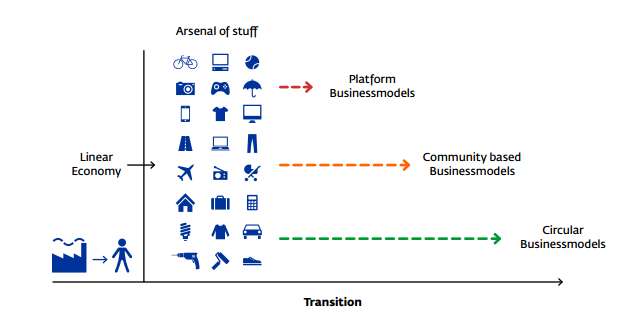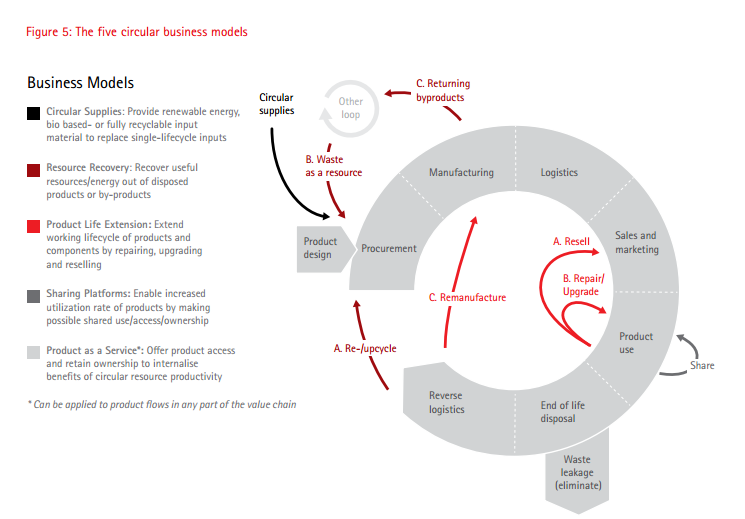Circular Economy
The Circular Economy is a challenge for the entire society, as it requires us to change our thinking about the use of the natural resources and the functioning of the economy. Currently, the industry operates a linear model of resource consumption by using the "take, use, and throw away" principle. Currently businesses extract natural resources, which are used to create goods and in turn are sold to their customers. Once the product reaches end of life, the goods are disposed off by being burned or end up as landfill. As a result, backed by numerous research, the functioning of this model is unsustainable, as our natural resources are decreasing, and the amount of waste generated by us is growing year by year.
According to Eurostat statistics, in 2014, the European Union countries produced 4.9 tons of waste for each inhabitant, of which 34.7% was construction waste, 28.2% mining waste, 10.2% industrial waste and 8.3% municipal waste. The report of the Central Statistical Office (GUS) shows that in 2017 the average Pole produced 303 kg of municipal waste, while 4 years earlier it was 280 kg. At the same time the European average was 475 kg of rubbish per head.
In recent years, with the emergence of alarming information about climate change and the risks associated to all on the planet, it has become clear that the current linear model needs to be transformed. The consumption-based economy should be remodeled to include the reuse of the resources used. This will require the introduction of systemic changes inside the current linear model, starting from the extraction of raw materials, followed by the design, production of the products and the way the products are sold. Further it also requires changing the habits of the consumers and lawmakers, ensuring that there is a demand for Circular Products and that the required changes can be introduced. Finally data published in the report "The circularity Gap report" by organization Circle Economy, analyzing data from various parts of the world, the consumption of resources, waste production and their final management indicated that the global economy is only 9.1% circular. This means that the remaining circular gap of 90.9% of waste is wasted! This is creating for governments, industry, scientist, consumers and all others involved both a huge opportunity as well as a huge complicated task ahead,
The chart below shows how to fill this circular gap, that is to close the loop of raw materials.

(żródło Circularity Gap Report)
In 2015, the European Union presented the "EU Action Plan for the Circular Economy", which proposes to member states, the introduction of an ambitious circular model. For years, EU recommendations have been mainly introduced by the Netherlands and Scotland, becoming European leaders in this field.
Linear economic model results
The linear model of the economy brings with it a number of disadvantages in the whole production process, from the moment of extraction of raw materials to their final stage of recycling. The most important of these disadvantages, is the decrease in natural resources and hence the increased risk of limited access to them. Further, losses in the value chain of materials, causing shortening of the life-cycle of the products and excessive production of waste impacting the ecosystem. These phenomena are further accelerated as both the world's population and wealth is growing rapidly.
1. Over the last 40 years, the number of consumers consuming the most valuable raw materials has doubled, resulting in a drastic increase in the extraction of natural resources. In 2011, we used 79 Gt of materials. It is estimated that by 2060 this number will more than double.

(żródło OECD Global Material Resources Outlook to 2060)
2. The awareness that the natural resources of the earth are limited while their extraction and consumption are growing year on year, is creating uncertainty about their availability in the near future. In addition, these fears are compounded by fluctuations in raw material prices and the rising demand from consumers for products (e.g. computers, mobile phones, cars etc..) and services (e.g. transportation, leisure, security etc...). (Circle Economy Source)
3. With the increase of raw material extraction, the amount of material lost in the chain between extraction and final production also grows. According to the Institute for Sustainable Europe (SERI) data, the production of products in OECD countries consumes over 21 billion tons of materials lost each year, which are not physically incorporated into the products themselves, that is materials that never enter the economic system. This includes, among others, overburden and separation materials in mining, by-catches from fisheries or losses in agricultural crop
Enormous losses in the value chain are also recorded by individual industries. According to Eurostat data, debris generated during the construction and demolition of waste constitutes 34.7% of all solid waste. It often contains recyclable materials, including steel, concrete and wood, but in most cases they can not be recovered. The problem with recycling results from the fact that the way the buildings are constructed makes it difficult or impossible to divide them into usable parts.

(source OECD Global Material Resources Outlook to 2060)
4. Also changing consumer habits impacts the linear model, causing the shortening of product life cycle and further threatening the ecosystem. Examples are consumers who like to change their mobile phone yearly to obtain the latest model or clothing chains producing cheap clothes enabling consumers to own many clothes which can be discarded after single or little use.
Western societies expect now that new products appear on the market yearly or even shorter time spans and producers are trying to meet those demands and provide new, improved versions. As a result of this phenomenon, good products still lie in drawers (telephones and other electronic and electrical devices) or are thrown into the trash. Some of them are then landfilled or incinerated. As the use of natural resources increases, along with consumption and the amount of waste generated, the ecosystem stops to fulfill its tasks. It is not able to renew its resources on an ongoing basis.
What is circular economy
Circular economy assumes that raw materials and products will remain in circulation as long as possible and their value will be maximized. As a result, we will extract less natural resources and produce less rubbish and those that will be created will be used again for production. We have distinguished several principles that guide the circular economy. The first step towards their implementation is to understand how materials circulate in a closed circle.

In a circular economy, materials circulate in two separate cycles, biological and technical as well as synthetic. Because they are processed in different processes, it is important to separate the two types of materials from each other. Then, after use, you will be able to recover them and introduce the recovered materials back into the production process.
In the case of technical materials such as fossil fuels, plastics and metals, which are often part of electronic devices, it is important to recover them, because it is in our interest to keep non-renewable materials in circulation as long as possible. This can be done primarily by repairing existing products or recycling them.
Renewable biological materials such as water and food, if not contaminated, are absorbed by the ecosystem after use. In the case of e.g. cotton, other solutions can be used. Wear the clothing sewn in from the clothes again as second / hand clothing, convert it into other items of clothing or use it to for other purposes (e.g. stuffing pillows).
-
Design products with thinking about their "life cycle"
The key of a successful circular process is the role of designers who have to incorporate the product's life cycle at the start of their work. Including what materials to combine with each other, so that after the product is used it can be separated again, recovered and processed. Further planning the design of the product is important, whether the product is disposable or can be dismantled, repaired, modernized or recycled. -
Use waste as a resource
Any waste should be considered as a source of resources that can be recovered and reused or recycled. -
Maintenance what has already been produced
Caring for the materials/products already created will allow them to prolong their live-cycle and thus reduce the amount of waste produced. That is why it is important to develop services around the products, such as servicing, modernization and repair. -
Increase the use of renewable energy
In circular economy, it is necessary to use renewable energy sources that do not contribute to increasing environmental pollution. -
Increased use of digital technology.
Many circular problems can be solved using digital technologies -
All stakeholders that make up the circular model must work together
Everybody who has influence on them, that is consumers, governments, local authorities, industry and scientists, must be involved in the circular transformation. Their tasks include sharing knowledge and experience, identifying problems and finding solutions and implementing them.
The role of business models
Traditional business models mainly focus on creating financial value, that is, drawing only financial profits, which must change under the assumptions of the circular economy. Professor Jan Jonker from the University of Radboud in Nijmegen points to the need to create business models that also take into account economic and social values. "For example, the added value of any activity may be to reduce loneliness among residents, reduce noise, or encourage people to grow vegetables in some area. Earning can therefore be seen as more than just money. " Following this idea, the professor distinguished three new business models> Platform, circular and community-based.

(source New Bussines Model, prof dr. J. Jonker)
-
Platform business models provide the opportunity to maintain circulation and better use of products that are not necessarily circular.
-
Community-based models assume the creation of value through the joint work of a group of people. A great example is the joint generation of energy or the shared use of a car.
-
The circular model is still in development. Professor Jonker described how he can function in practice
a. Close the loop. Enterprises, in order to keep natural materials in circulation, may re-use the products and parts containing them, or use, for example, renewable biological materials. The essence in this aspect is that the raw material is no longer seen as something temporary, but it will exist in the cycle for as long as possible.
b. Replacement of ownership with services. When designing products as a service, the producer remains the owner and the customer leases, rents or lends them. At the same time, the owner must take away the circularity of the products and their recycling.
c. Intensifying the use of product functionality. For example, a car stands in the parking lot for 22 hours a day, the drill is used for 10 to 20 hours for the entire lifetime. This means that tools, buildings and vehicles as well as many other things are not optimally used, and a new business model could allow them to be shared with several people, or at least hire them. This is facilitated by the loan platforms.
A slightly different vision into innovative business models has been developed by the consulting company Accenture. After analyzing the business models of 120 enterprises that already implement the principles of circular economy, it has identified the 5 most popular ones today.
-
Circular materials> Companies use renewable materials that can be recycled or biodegradable
-
Resource Recovery> Allows the company to recover and reuse of materials
-
Extending the life of products> Companies maintain materials in circulation through better quality, repairs, modernization and regeneration
-
Sharing platform> Promotes collaboration among consumers and encourages them to borrow or exchange products.
-
Product as a service> Provides an alternative to the traditional consumption model "buy and be a landlord". The products are used by one or many clients under a lease or payment for use.

(source Accenture ”Circular adventage”)
Benefits resulting from the introduction of circular economy
Analysts have no doubt that although the process of transforming the economy will be difficult, it will prove beneficial for the people, economy and the environment in the long term.
According the data developed by McKinsey & Co, circular GDP model is growing. "This is the expected result of the combination of increased revenues from new circular activities and cheaper production by obtaining more functionality from materials and other" inputs ". The effect of this difference in inputs and production leads to a higher valuation of labor, and thus to increased income and expenditure on the household. This results in higher GDP "(Ellen MacArthur Foundation).
With the development of circular economy, jobs will be created. The European Union envisages the creation of 2 million vacancies in its area, mainly in logistics, recycling, services related to the repair and modernization of products and in sales platforms that will prolong the life of products through their re-sale.
One of the positive consequences of the transition from a linear model of economy to circular will help to reduce CO2 emissions (climate change) and protect us from depletion of natural resources. It has been calculated that the circular model will allow us to save natural resources at the level of 70% compared to the linear model. Even as the world population will continue to grow, generating more demand, it is still expected that the extraction of raw materials will go down, as products with a prolonged life will stay in circulation for longer. (source: Ellen McArthur Foundation)
Proponents of the transformation of the circular economy must now convince the unconvinced that it is worth making the initial investment towards a circular model, so that we do not have to worry about the state of the environment and depletion of the natural resources and still be able to grow the global economy. Skeptical entrepreneurs unwilling to change their business model, will be forced by the market and the pressure exerted on them by circular business partners and circular customers. In the interests of having a thriving business, they will have to start the transformation process sooner or later. There is also the issue of linear consumers who will not want to change their habits due to the labor intensity and length of this process. There is a chance that the change in their attitudes will be influenced by the quality and diversity of services and products offered to them. Cheaper, more solid, modular and repairable multifunctional goods can gain their favor.
Sources
- Fundacja Ellen MacArthur “Towards the circular economy”
- Prof. Dr Jan Jonker “News bussiness models”
- Circular Economy, “The Circularity GAP report”
- Holland Circular Hotspot
- www.accenture.com “Insight circular adventage”, “Circular Adventage”
- Eurostat
- OECD Global Material Resources Outlook to 2060